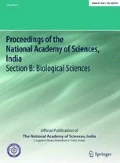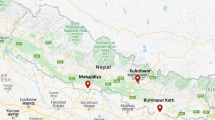Abstract
Bacterial wilt caused by Ralstonia solanacearum is a soil borne disease affecting several plant species of different genera. Management of this disease with various strategies provided limited success. Plant product in the management of bacterial wilt is one of the minimum explored areas. In the present study attempts were made to exploit the antibacterial properties of the locally available plant species for the inhibition of R. solanacearum and also to characterize the phytochemicals in two of the promising plant species by Gas Chromatography–Mass Spectrometry (GC–MS). Thirty-two plants species were screened for their antimicrobial activity against R. solanacearum using eight organic solvents. Out of the 264 tested extracts 123 showed zones of inhibition under in vitro condition. It was observed that alcohol extracts showed better activity against R. solanacearum as compared to other solvents. Two plant species viz. Garcinia indica and Tamarindus indica were highly inhibitory to the pathogen. The phytochemical analysis indicated the presence of saponins, terpenoids, alkaloids, flavonoids and tannins in the extracts. Fractions from solvent–solvent partitioning indicated that alcohol based fraction (Fraction III) was inhibitory to the pathogen. GC–MS analysis of Fraction-III revealed the presence of phytoconstituents viz. 4H-pyran-4-one,2,3-dihydro-3,5-dihydroxy-6-methyl and 2-Furancarboxaldehyde, 5 (hydroxymethyl) in G. indica; butanoic acid, and myo-inositol, 4-C-methyl in T. indica. The present study is the first report on the use of G. indica and T. indica in inhibiting R. solanacearum and the antimicrobial constituents of the extracts.





Similar content being viewed by others
References
Wicker E, Grassart L, Coranson-Beaudu R, Mian D, Guilbaud C, Fegan M (2007) Ralstonia solanacearum strains from Martinique (French West Indies) exhibiting a new pathogenic potential. Appl Environ Microb 71:6790–6801
Singh R, Vani A, Kishnareddy M (1997) Molecular differentiation of Ralstonia solanacearum isolates from India. In: Abstract published at 2nd Bacterial wilt symposium, Guadeloupe, French West Indies
Hayward AC (1991) Biology and epidemiology of bacterial wilt caused by P. solanacearum. Annu Rev Phytopathol 29:65–87
Saddler GS (2005) Management of bacterial wilt disease. In: Allen C, Prior P, Hayward AC (eds) Bacterial wilt: the disease and the Ralstonia solanacearum species complex. APS Press, New York, pp 121–132
Gopalakrishnan TR, Singh PK, Sheela KB, Shankar MA, Kutty PCJ, Peter KV (2005) Development of bacterial wilt resistant varieties and basis of resistance in eggplant Solanum melongena L. In: Allen C, Prior P, Hayward AC (eds) Bacterial wilt: the disease and the Ralstonia solanacearum species complex. APS Press, New York, pp 293–300
Guo JH, Qi HY, Guo YH, Ge HL, Gong LY, Zhang LX, Sun PH (2004) Biocontrol of tomato wilt by plant growth-promoting rhizobacteria. Biol Control 29:66–72
Lemaga B, Kanzikwera P, Kakulenzire R, Hakiza JJ, Maniz G (2001) The effect of crop rotation on bacterial wilt incidence and potato tuber yield. Afr Crop Sci J 9:267–278
Ramesh R, Ghanekar A, Joshi M (2009) Pseudomonads: major antagonistic endophytes to suppress bacterial wilt pathogen, Ralstonia solanacearum in eggplant (Solanum melongena L.). World J Microbiol Biotechnol 25:47–55
Getachew A, Chemeda F, Seid A, Kerstin W (2011) Effects of soil amendment on bacterial wilt caused by R. solanacearum and tomato yields in Ethiopia. J Plant Prot Res 51:72–76
Alemu M, Morkbak M, Olsen S, Jensen C (2013) Attending to the reasons for attribute non-attendance in choice experiments. Environ Resour Econ 54:333–359
Dorman HJD, Deans SG (2000) Antimicrobial agents from plants: antibacterial activity of plant volatile oils. J Appl Microbiol 88:308–316
Harborne IB (1973) Phytochemical methods: a guide to modern techniques of plant analysis, 2nd edn. Chapman and Hall, New York, pp 88–185
Gurjar MS, Ali S, Akhtar M, Singh KS (2012) Efficacy of plant extracts in plant disease management. Agric Sci 3:425–433
Abera A, Lemessa F, Muleta D (2011) The antifungal activity of some medicinal plants against coffee berry disease caused by C. kahawae. Int J Agric Res 6:268–279
Ji P, Momol MT, Olson SM, Pradhanang PM, Jones JB (2005) Evaluation of thymol as biofumigant for control of bacterial wilt of tomato under field conditions. Plant Dis 89:497–500
Deberdt P, Perrin B, Coranson-Beaudu R (2012) Effect of A. fistulosum extract on R. solanacearum populations and tomato bacterial wilt. Plant Dis 96:687–692
Sangoyomi TE, Owoseni AA, Adebayo OS, Omilani OA (2011) Evaluation of some botanicals against bacterial wilt of tomatoes. Int Res J Microbiol 2:365–369
Moussa AM, Emam AM, Mohamed MA, Diab YM (2010) In vitro evaluation of some Egyptian plants against the rot bacteria and spider mite and isolation the active constituent(s) from Myrtus communis leaves. Int Food Res J 17:287–294
Sunder J, Jeyakumar S, Kundu A, Srivastava RC, Kumar DEA (2011) Effect of Morinda citrifolia extracts on in vitro growth of Ralstonia solanacearum. Arch Appl Sci Res 3:394–402
Subin MP, Dilna N (2012) Phytochemical screening and in vitro antibacterial activity of three selected plant extracts against some phytopathogenic bacteria. Bull Pure Appl Sci 31:11–23
Raghavendra MP, Satish S, Raveesha KA (2009) Alkaloids isolated from leaves of Prosopis juliflora against Xanthomonas pathovars. Arch Phytopathol Plant Prot 42:1033–1041
Cowan MM (1999) Plant products as antimicrobial agents. Clin Microbiol Rev 12:564–582
Ramesh R, Phadke GS (2012) Rhizosphere and endophytic bacteria for the suppression of eggplant wilt caused by R. solanacearum. Crop Prot 37:35–41
Kumar A, Sarma YR, Anandaraj M (2004) Evaluation of genetic diversity of R. solanacearum causing bacterial wilt of ginger using REP-PCR and PCR-RFLP. Curr Sci 8:1555–1561
Opina N, Tavner F, Hollyway G, Wang JF, Li TH, Maghirang R, Fegan M, Hayward AC, Krishnapillai V, Hong WF, Holloway BW, Timmis J (1997) A novel method for development of species and strain-specific DNA probes and PCR primers for identifying Burkholderia solanacearum (formerly Pseudomonas solanacearum). Asia-Pacific J Mol Biol Biotechnol 5:19–30
Fegan M, Prior P (2005) How complex is the “Ralstonia solanacearum species complex?”. In: Allen C, Prior P, Hayward AC (eds) Bacterial wilt: the disease and the Ralstonia solanacearum species complex. APS Press, New York, pp 449–461
Shahidi BGH (2004) New approaches in screening for antibacterials in plants. Asian J Plant Sci 3:55–60
Okwu DE (2005) Phytochemicals, vitamins and mineral contents of two Nigeria medicinal plants. Int J Mol Med Adv Sci 1:375–381
Trease GE, Evans WC (1989) Pharmacognosy, 11th edn. Brailliar Tiridel and Macmillan Publishers, London
Mehta K, Patel BN, Jain BK (2013) Phytochemical analysis of leaf extracts of Phyllanthus fraternus. Res J Recent Sci 2:12–15
Sofowora AE (1993) Medicinal plants and traditional medicines in Africa, 2nd edn. Spectrum Books, Ibadan, p 289
Terefa M, Geyid A, Debella A (2010) In vitro anti-Neisseria gonorrhoeae activity of Albizia gummifera and Croton macrostachyus. Revista CENIC, Ciencias Biológicas 41:1–11
Hayward AC (1964) Characteristics of Pseudomonas solanacearum. J Appl Bacteriol 27:265–277
Chanda S, Dave R, Kaneria M, Nagani K (2010) Seaweeds: a novel, untapped source of drugs from sea to combat infectious diseases. Curr Res Technol Educ Top Appl Microbiol Microb Biotechnol 1:473–480
Owoseni AA, Sangoyomi TE (2014) Effect of solvent extracts of some plants on R. solanacearum. Br Microbiol Res J 4:89–96
Wagura AG, Wagai SO, Manguro L, Gichimu BM (2011) Effects of selected plants extracts on in vitro growth of R. solanacearum (Smith), the causal agent of bacterial wilt of Irish potatoes. Plant Pathol J 10:66–72
Chanda S, Kaneria M (2011) Indian nutraceutical plant leaves as a potential source of natural antimicrobial agents. In: Mendez-Vilas A (ed) Science against microbial pathogens: communicating current research and technological advances. Formatex, Spain, pp 1251–1259
Abreu P, De Ortiz RM, de Castro SC, Pedrazzoli J (2003) HPLC determination of amoxicillin comparative bioavailability in healthy volunteers after a single dose administration. J Pharm Pharm Sci 6:223–230
Vinoth B, Manivasagaperumal R, Balamurugan S (2012) Phytochemical analysis and antibacterial activity of Moringa oleifera Lam. Int Res J Biol Sci 2:98–102
Alam MT, Karim MM, Khan SN (2009) Antibacterial activity of different organic extracts of Achyranthes aspera and Cassia alata. J Sci Res 1:393–398
Rasooli I, Mirmostafa SA (2002) Antimicrobial activity of T. pubescens and T. seyphyllum essential oils. Fitoterapia 73:244–250
Gobalakrishnan R, Manikandan P, Bhuvaneswar R (2014) Antimicrobial potential and bioactive constituents from aerial parts of V. setosa wall. J Med Plants Res 8:454–460
Varalakshmi KN, Sangeetha CG, Shabeena AN, Sunitha SR, Vapika J (2010) Antimicrobial and cytotoxic effects of Garcinia indica fruit rind extract. Am Eurasian J Agric Environ Sci 7:652–656
Nwodo UU, Obiiyeke GE, Chigor VN, Okoh AI (2011) Assessment of Tamarindus indica extracts for antibacterial activity. Int J Mol Sci 12:6385–6396
Arya C (1999) Post infectional changes in flavonoids and phenolic acids by fungal pathogens in Tamarindus indica L. Res J Chem Environ 3:305–317
Ogunkunle J, Tonia AL (2006) Ethnobotanical and phytochemical studies on some species of Senna in Nigeria. Afr J Biotechnol 5:2020–2023
Anyasor GN, Ogunwenmo KO, Oyelana OA, Akpofunure BE (2010) Phytochemical constituents and antioxidant activities of aqueous and methanol stem extracts of Costus afer Ker Gawl. (Costaceae). Afr J Biotechnol 9:4880–4884
Zhao X, Wenli M, Gong M, Zuo W, Bai H, Dai H (2011) Antibacterial activity of the flavonoids from Dalbergia odorifera on R. solanacearum. Molecules 16:9775–9782
Acknowledgments
The authors acknowledge the financial support by Indian Council of Agricultural Research, New Delhi, India through “Outreach project on Phytophthora, Fusarium and Ralstonia diseases of horticultural and field crops” (PhytoFuRa) and the Director ICAR-CCARI Goa for the facilities. They also thank Sophisticated Analytical Instrument Facility, Indian Institute of Technology—Bombay, Powai, Mumbai for helping them to carry out GC–MS analysis.
Author information
Authors and Affiliations
Corresponding author
Ethics declarations
Conflict of interest
We declare that we have no conflict of interest.
Rights and permissions
About this article
Cite this article
Gaitonde, S.S., Ramesh, R. Screening Plant Products for Ralstonia solanacearum Inhibition and Characterization of Antibacterial Compounds in Garcinia indica and Tamarindus indica . Proc. Natl. Acad. Sci., India, Sect. B Biol. Sci. 88, 265–276 (2018). https://doi.org/10.1007/s40011-016-0755-6
Received:
Revised:
Accepted:
Published:
Issue Date:
DOI: https://doi.org/10.1007/s40011-016-0755-6



